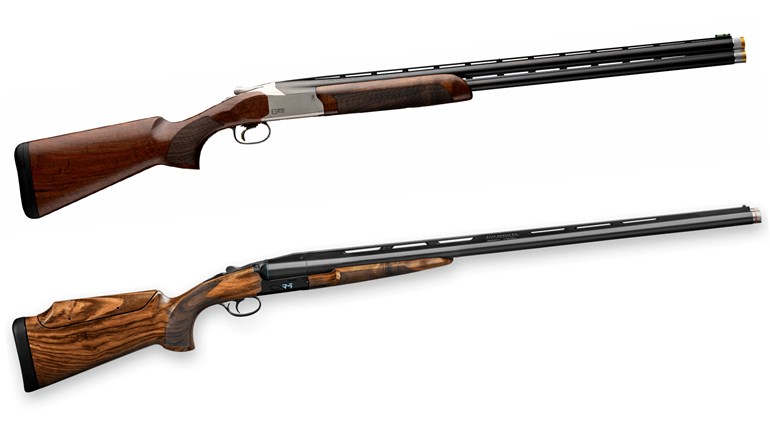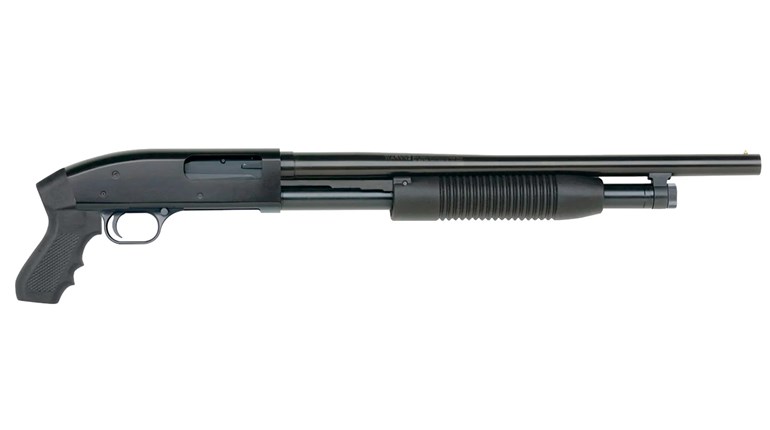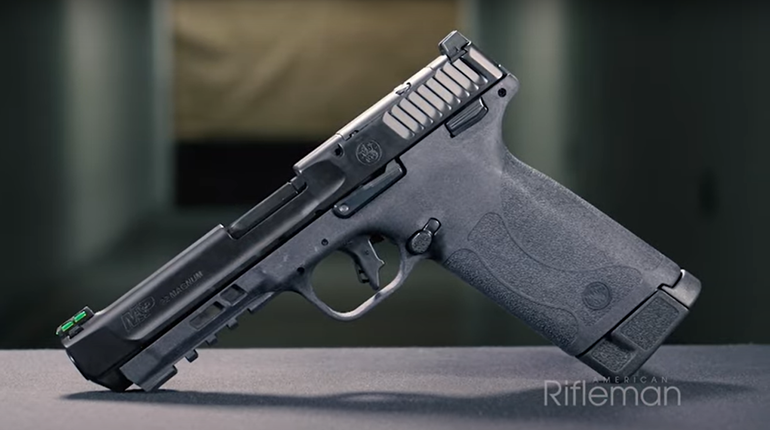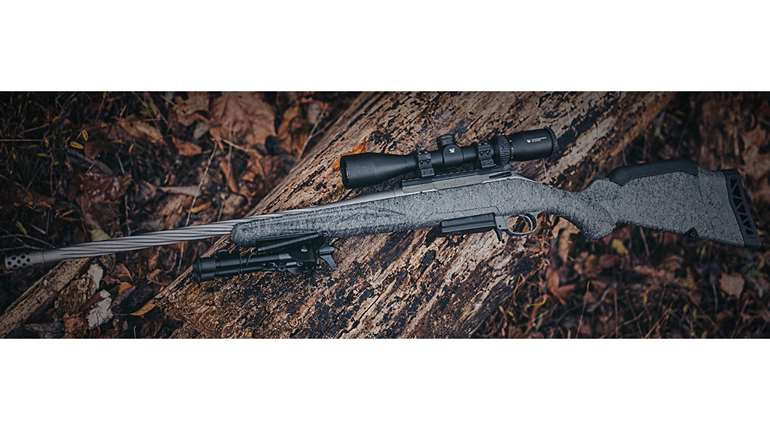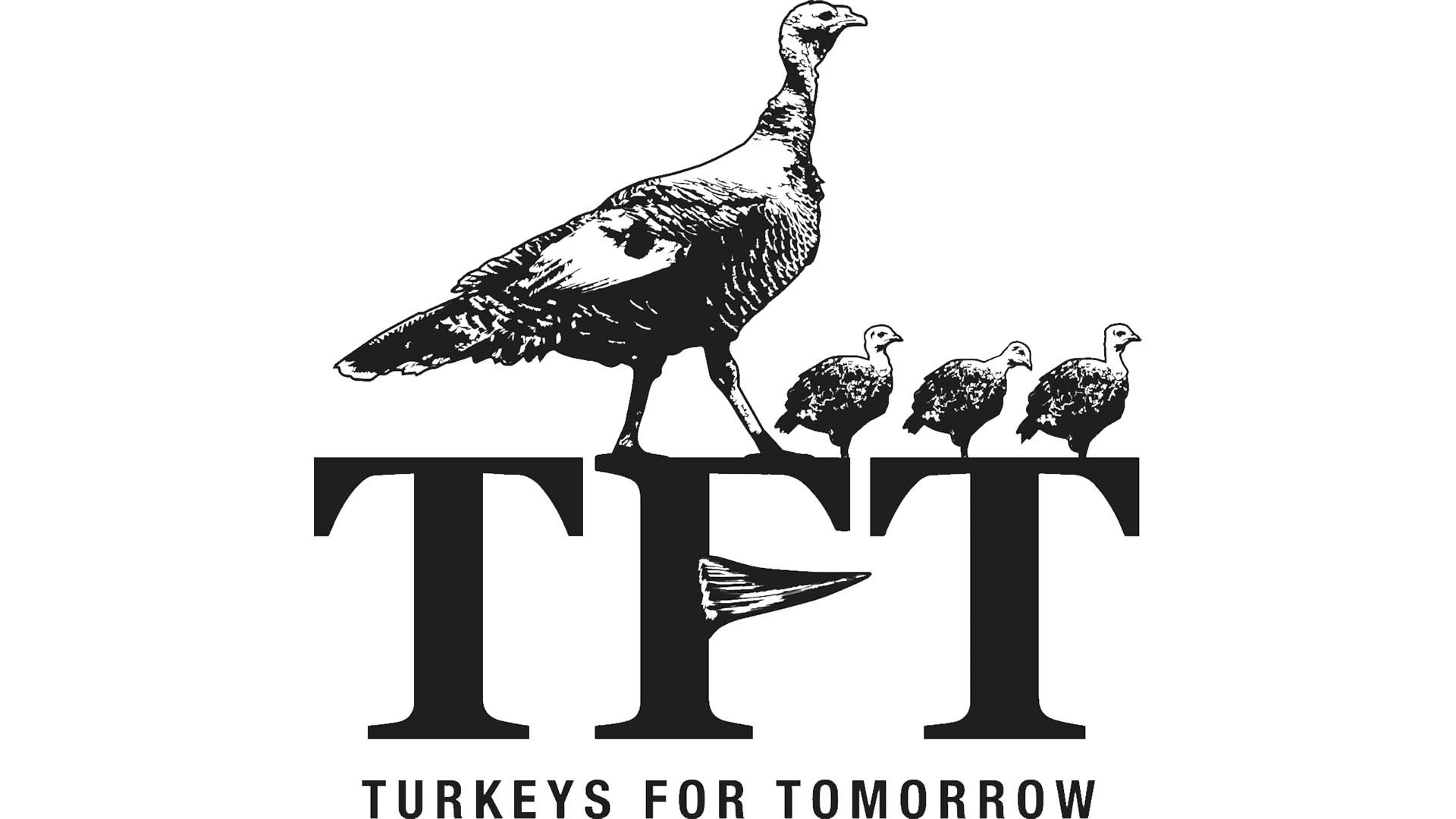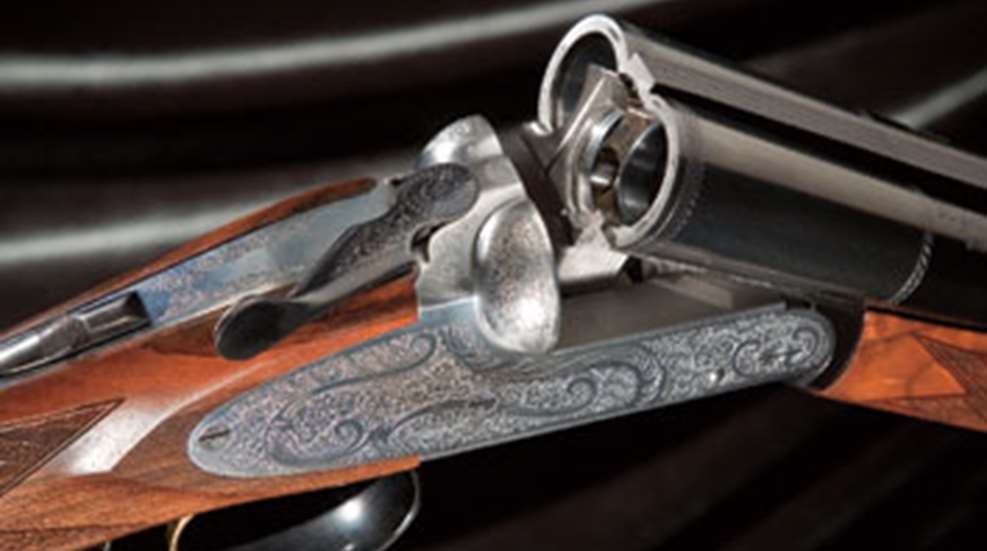
After I put the new PA-08 shotgun together, I called Weatherby’s PR man, Aaron Smith. “Aaron, I’m going to ask you a question and you have to tell me the truth,” I said. “Did you pick out the PA-08 you sent me or just send one from the warehouse?”
“I’ve never seen it before. Why?” he asked apprehensively.
“Because it has the most beautiful wood I’ve seen on a $400 shotgun.”
The PA-08 is Weatherby’s new pump-action. Sourced from a Turkish vendor, it’s made to sell at a low price point—in this case $389. But even inexpen- sive Turkish guns usually have well-finished, well- figured wood, and this particular one was spectacular.
In that way, this new gun remains true to Weath- erby’s shotgun heritage, which began nearly 40 years ago. Weatherby shotguns were made to be admired, just like Weatherby rifles. The PA-08 is as handsome as a budget pump-action can possibly be, and although most have plainer wood than my sample gun, they are uniformly well-finished and good-looking.
Weatherby has always sourced its shotguns from overseas vendors, beginning with the high-grade, Italian-made Regency over-under in 1970. Today, the line has broadened and evolved to comprise every- thing from the $389 pump and a surprisingly good, inexpensive $449 semi-automatic on up to double guns and over-unders selling for nearly $4,000.
Weatherby Shotgun History
Sixty-three years ago insurance salesman Roy Weatherby began tinkering with custom rifles and high- velocity cartridges in his southern California garage. Weatherby had the right idea for the time and place. As America raced into a bright and prosperous future, the Mark V, a super-high-velocity rifle with radical, eye- catching lines, reflected the spirit of the age. Weatherby was an innovator and also a shrewd marketer. He took full advantage of his location near Hollywood: He made sure movie stars shot his rifles, and Weatherby himself appeared on national television. A studio once sent Burt Lancaster with a photographer to Weatherby’s sporting goods store to take a picture of him with Roy and a rifle in order to promote the actor as a hunter. The Weatherby brand stood for glamour and post-war prosperity.
Weatherby manufacturing took place in Southgate, Calif., until rising costs forced it overseas. By the 1960s, the German firm of J.P. Sauer was building Mark V rifles. When Weatherby introduced a shotgun in 1969-70, he worked with Angelo Zoli of Brescia, Italy. (Angelo Zoli folded in 1987, and should not be confused with Anto- nio Zoli, which is still in business today).
The result of the collaboration was the Regency over-under, which sold for $500 at a time when a Belgian Browning Superposed cost $440. For that price, customers received a beautiful gun. Like all Weatherbys, it was stocked in Claro walnut with a gloss finish. It had the distinctive rosewood grip cap with a white line spacer and a white diamond on the bottom. The false sideplates were covered with ornate engraving. The action locked by means of a Greener crossbolt, a very strong, low-profile design. The field version came with Skeet or field chokes in 12 and 20 gauge, and there was a trap gun as well.
European inflation drove the price of a Regency to $1,000 by 1977, paving the way for a move to Japanese production for the entire shotgun line. Weatherby was already working with the Japanese on the Mark XXII semi-automatic rimfire, and he partnered with KTG and Nikko/ Kodensha on the new Patrician pump and Centurion semi-auto- matic. Both were introduced in 1972 and were easily identifiable by their distinctive fore-ends, which hid all but the end of the magazine cap. Weatherby also contracted with Nikko/Kodensha, makers of the Winchester 101, to make the Olympian over-under, a grade below the Regency.
Both Nikko/Kodensha and KTG filed for bankruptcy in 1980. A reorganized KTG continued to make Weatherby repeating shot- guns. The Patrician and Centurion were discontinued in 1982 in favor of the Model 82 semi-automatic, a new design that shot both stan- dard and magnum loads, and the 92 pump, which shared the semi- humpback profile of the new semi- automatic.
Meanwhile, Weatherby found a new vendor for over-under guns: SKB. Gunsmith Shigyo Sakaba was the original “SKB,” founding a small shop northeast of Tokyo in 1855. The SKB guns were excel- lent shooters and a good value, with a crossbolt action inspired by the German Merkel. SKB made Weatherby shotguns for more than 25 years, and they have a well-deserved reputation as good, reliable guns. My early ’80s vintage Orion served as my main pheasant gun for several seasons and, while the trademark Claro walnut stock and forearm were a little bulky, it did a fine job for me. The SKBs came in Athena (with sideplates) and Orion versions, each in multiple grades, in four gauges and many different con- figurations. Through the years, the SKB/Weatherbys evolved to suit changing tastes, and the last of the Japanese-made over-unders were very nice indeed, with slim lines, Prince of Wales grips and satin- finished wood.
Weatherby made a return to the semi-automatic market in 1999 with the SAS shotgun made by Valtro in Italy. I had one that worked well, and with a slug barrel it was deadly accurate. The gun, however, was never widely popular, and it was discontinued in 2007.
Just as European price increases sent Weatherby to Japan in the ’70s, rising costs in Japan recently forced the company to switch vendors again. Weatherby went back to Italy for break-action guns, and to Turkey for semi-automatics and pumps. Here’s where the Weath- erby shotgun line stands today:
The Weatherby Lineup
Weatherby still offers two models of over-unders: the Orion and the Athena. Both are the same gun mechanically, but the Athena has better wood and sideplates allowing for more decoration. In recognition of the switch from SKB to Italian maker Fausti Stefano, the appellation “d’Italia” has been added to both names. These are completely different guns than the previous SKB-made versions. The new over-unders feature an action Weatherby calls the “four- lock system.” As with many Italian over-unders the barrels rotate on trunnions and the guns lock up via a Browning/FN-style underbolt that engages a lug beneath the bottom barrel. For added strength, the Weatherby guns have two more “locks” in the form of recoil shoul- ders machined on the inside of the receiver that fit into matching recesses cut into the sides of the monobloc. The action should stand up to a lot of pounding.
I shot the Grade II and found it to be both good-looking and easy to hit with. The medium-dark Claro walnut has a fairly straight grain with sharply cut checker- ing, a glossy finish and a rounded Prince of Wales grip. The acanthus scroll and gamebird engravings on the silver receiver look machine- cut and can politely be called “robust.” Although the engraving looks crude in extreme close-up, it shows up well at arm’s length, the distance at which the finer roll engraving on many guns disap- pears from view. The Grade I has the same pattern on a blued receiver. The Grade III does as well, but with gold-inlaid birds.
The barrels are threaded for Weatherby’s “Integral Multi- Chokes” (IMC), which are compat- ible with the standard Invector tubes of the old SKB Weatherbys. The automatic safety has the Beretta-style barrel selector on top. The inertia-set triggers have pleasingly light pulls.
My sample Grade II weighed just under 7 lbs., 8 ozs. and felt a bit heavier in the barrels than I like for an upland gun. That extra weight did prove to help on the skeet field. Starting at $1,699, the Orion d’Italia line offers good hunting guns at a price that’s competitive with comparable over-unders. The Athenas start at $2,599.
When it comes to side-by-sides, the Athena d’Italia from Fausti has been in the Weatherby line since 2004. It is a classic two-trigger, straight-grip gun that comes in three models; the Athena d’Italia, the Athena d’Italia PG (the same gun with a pistol grip, single trig- ger and wider forearm) and a highly decorated, single-trigger Athena d’Italia Deluxe. There’s also an Orion d’Italia—essentially the same gun as the Athena PG but with plainer wood, no sideplates and a lower price tag of $2,199.
All the guns are built around a Purdey-style underbolt with a sliding latch that locks into bites on the lumps under the barrel. It’s an old, proven system, as is the Anson-style pushrod that holds the fore-end in place. The single triggers are non-selective, and the safeties are manual. All four models have ejectors. The 12- and 20-ga. guns have screw-in chokes; the Deluxe and all 28 gauges have fixed improved-cylinder and modi- fied chokes.
As with the over-under line, the Athena models have more deco- ration and some gold inlay. The Athena PG has a skip-line checker- ing pattern that Weatherby calls a “new Scottish” design. It’s striking, although not to my personal taste. I had a chance to try the Athena d’Italia at the Flying B Ranch in Idaho on strong-flying released birds. At slightly more than 6 lbs. in the 20-ga. models, it was light but had enough forward weight to feel just right. With its trim lines it proved an easy gun for me to shoot. Even though I had to remind myself to reach for the back trigger after shooting the first barrel (I’m a long- time single-trigger shooter), I even doubled a few times on pheasants and chukar over the Flying B’s fine pointing dogs.
The Weatherby PA-08 pump- action comes only in 12 gauge, 3", and in one style so far: a walnut and blued Upland version with an alloy receiver. As I mentioned, it’s a well-finished gun with looks that belie its budget price tag of $389, which makes it an excellent value. The slide works smoothly on twin action bars and the gun is fairly light and lively at under 7 lbs. I’ve shot several rounds of skeet with it with no failures of any kind. Currently, it comes with a choice of 26" or 28" barrels. Weatherby originally announced synthetic- and tactical-stocked versions and, although they have disappeared from the catalog, my guess is we will see them again soon.
Of all the new guns in the Weath- erby shotgun lineup, the SA-08 is attracting the most attention right now. And, perhaps, just as Weath- erby rifles struck a chord with consumers during the prosperous post-war era, so a semi-automatic at $449 is the right gun for today’s economic hard times. Whatever the case, the SA-08 delivers reliable semi-automatic performance at the price of a pump gun.
There’s nothing high-tech about the SA-08. It comes with two pis- tons, one for light dove and target loads and one for heavier loads. The pistons interchange in the time it takes to remove the barrel, slide the old piston off and put the new one on. Besides the piston, there’s just one other part to the gas system: a sleeve with an action bar brazed to it. It’s easy to maintain, and it works very well.
At a Pheasants Forever shooting event I attended recently, partici- pants loved the lightweight 20-ga. SA-08 even before they found out how little it costs. The shoot- ers liked the slim lines and light weight of the SA-08, which weighs about 6 lbs. in 20 gauge, and only 6 lbs., 8 ozs. in 12 gauge. Despite their lack of weight, both gauges are fairly soft shooting because of their gas operation. The SA-08 should make a lot of bird hunters happy. To promote the new gun, Weatherby is holding a sweep- stakes with 20 SA-08s as prizes.
Besides, the $449 synthetic version, the SA-08, comes with wood stocks in both full-size and youth models. The wood-stocked models sell for $669 and have matte-finished wood and fairly dull metal, so they won’t spook water- fowl if you choose to take them to the blind. Although the SA-08 is certainly not the first Turkish semi- automatic to be sold here, and while some, like the Stoeger 2000 have a following, this might be the gun that brings wide-spread acceptance to Turkish-made auto- loaders among American shooters.
The Weatherby shotgun lineup has grown and evolved since the importation of the Regency over-under in 1970 to the point at which Weatherby offers a shotgun to meet almost any budget. For almost 40 years Weatherby hasn’t just meant rifles, and the current lineup offers more choices to shot- gunners than ever before.












